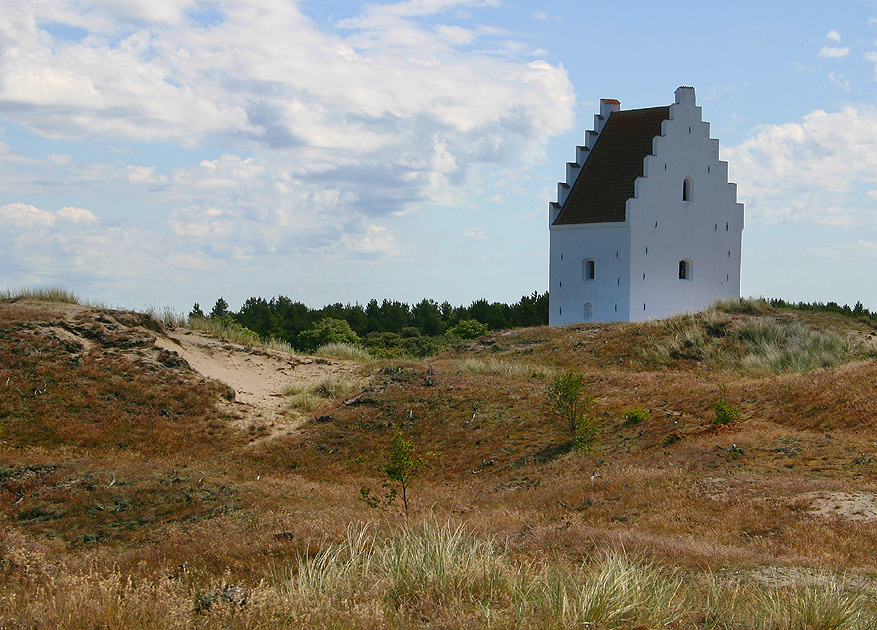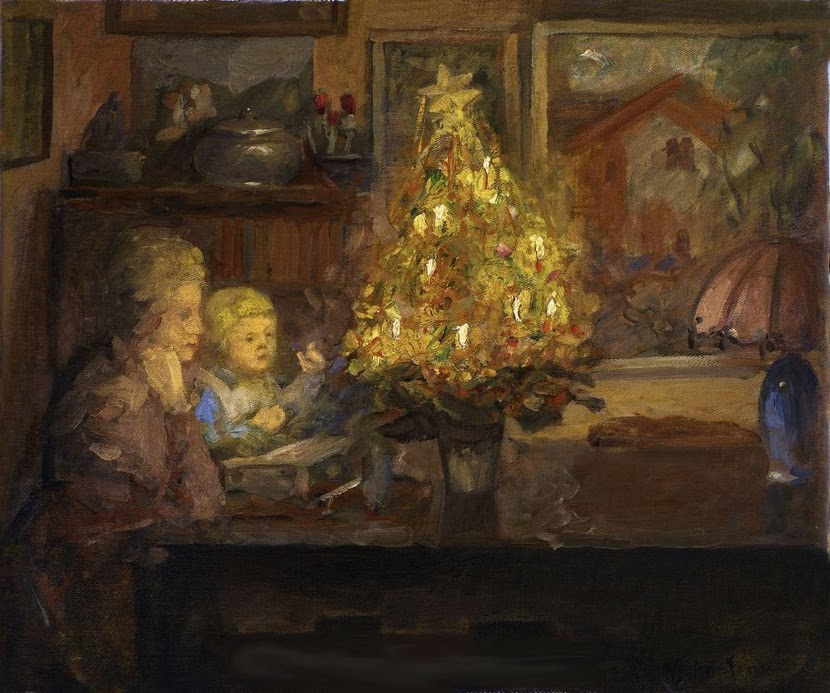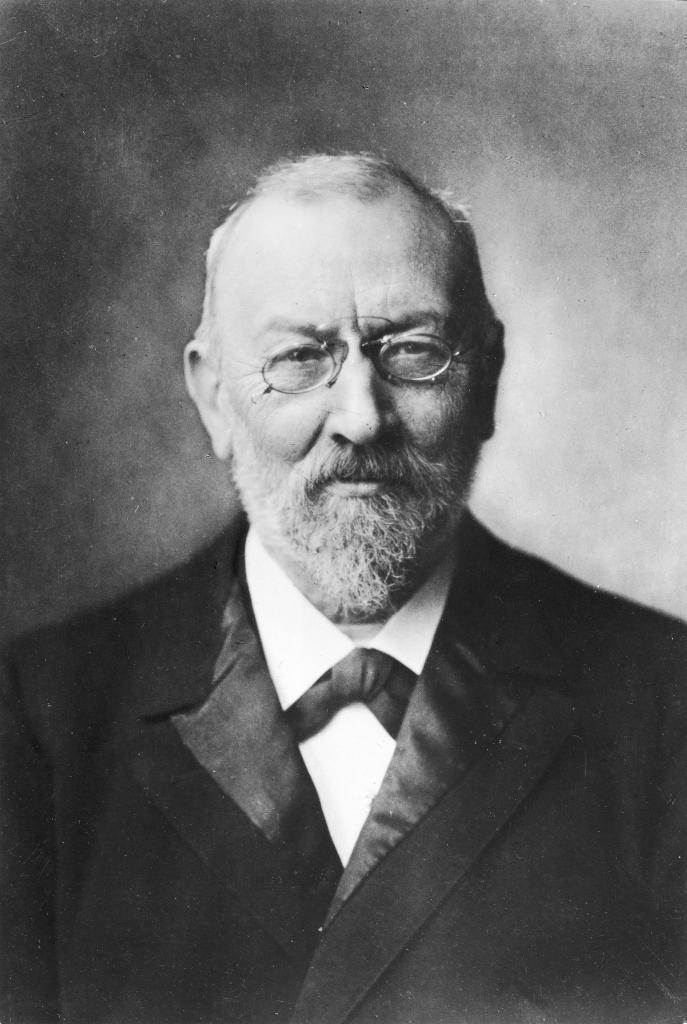|
Brøndums Hotel
Brøndums Hotel, in the little harbor town of Skagen in the north of Denmark, is remembered for its close associations with the late 19th-century artists colony known as the Skagen Painters. It still operates as a hotel today. History The hotel originated in a farmhouse which Ane Kirstine Houmann (1785–1858) had inherited from her stepfather Chresten Jensen Degn (1760–1839). After the death of her husband Anders Eriksen Brøndum (1781–1835), her son Erik Andersen Brøndum (1820–1890) helped her to run the grocery shop and guest house which she established in the old farmhouse. Erik and his wife Anne Hedvig Sørensdatter Møller (1826–1916) later ran the business together until it was taken over by their son Christen Degn Brøndum (1856–1932) who converted it into guest rooms and in 1891 gave it the name of Brondums Hotel. Their daughter, the painter Anna Ancher (1859–1935) was born in the hotel. The architect Ulrik Plesner was called upon to expand the hotel in 1 ... [...More Info...] [...Related Items...] OR: [Wikipedia] [Google] [Baidu] |
Skagen
Skagen () is Denmark's northernmost town, on the east coast of the Skagen Odde peninsula in the far north of Jutland, part of Frederikshavn Municipality in Nordjylland, north of Frederikshavn and northeast of Aalborg. The Port of Skagen is Denmark's main fishing port and it also has a thriving tourist industry, attracting 2 million people annually. The name was applied originally to the peninsula but it now also refers to the town. The settlement began during the Middle Ages as a fishing village, renowned for its herring industry. Thanks to its seascapes, fishermen and evening light, towards the end of the 19th century it became popular with a group of impressionist artists now known as the Skagen Painters. In 1879, the Skagen Fishermen's Association was established with the purpose of facilitating the local fishing industry through the Skagensbanen railway, which opened as a narrow-gauged railway in 1890. The modern port of Skagen opened on 20 November 1907, and ... [...More Info...] [...Related Items...] OR: [Wikipedia] [Google] [Baidu] |
Karen Blixen
Baroness Karen Christenze von Blixen-Finecke (born Dinesen; 17 April 1885 – 7 September 1962) was a Danish author who wrote works in Danish and English. She is also known under her pen names Isak Dinesen, used in English-speaking countries, Tania Blixen, used in German-speaking countries, Osceola, and Pierre Andrézel. Blixen is best known for ''Out of Africa'', an account of her life while living in Kenya, and for one of her stories, ''Babette's Feast'', both of which have been adapted into Academy Award–winning motion pictures. She is also noted, particularly in Denmark, for her ''Seven Gothic Tales''. Among her later stories are ''Winter’s Tales'' (1942), ''Last Tales'' (1957), ''Anecdotes of Destiny'' (1958) and ''Ehrengard'' (1963). Blixen was considered several times for the Nobel Prize in Literature, but it wasn't awarded because judges were reportedly concerned about showing favoritism to Scandinavian writers, according to Danish reports. Biography Early lif ... [...More Info...] [...Related Items...] OR: [Wikipedia] [Google] [Baidu] |
Buildings And Structures In Skagen
A building, or edifice, is an enclosed structure with a roof and walls standing more or less permanently in one place, such as a house or factory (although there's also portable buildings). Buildings come in a variety of sizes, shapes, and functions, and have been adapted throughout history for a wide number of factors, from building materials available, to weather conditions, land prices, ground conditions, specific uses, prestige, and aesthetic reasons. To better understand the term ''building'' compare the list of nonbuilding structures. Buildings serve several societal needs – primarily as shelter from weather, security, living space, privacy, to store belongings, and to comfortably live and work. A building as a shelter represents a physical division of the human habitat (a place of comfort and safety) and the ''outside'' (a place that at times may be harsh and harmful). Ever since the first cave paintings, buildings have also become objects or canvasses of much artistic ... [...More Info...] [...Related Items...] OR: [Wikipedia] [Google] [Baidu] |
Anna Palm De Rosa
Anna Sofia Palm de Rosa (25 December 18592 May 1924) was a Swedish artist and landscape painter. In the 1890s she became one of Sweden's most popular painters with her watercolours of steamers and sailing ships and scenes of Stockholm. She also painted a memorable picture of a game of cards in Skagen's Brøndums Hotel while she spent a summer with the Skagen Painters. At the age of 36, Anna Palm left Sweden for good, spending the rest of her life in the south of Italy, where she married an infantry officer. Early life and education Born on Christmas Day 1859 in Stockholm, Palm de Rosa was the daughter of the painter Gustaf Wilhelm Palm and Eva Sandberg, who was the daughter of the painter Johan Gustaf Sandberg. The family home at No. 19 Barnhuträdgårdgatan (today Olof Palmas Gata) was a popular meeting place for their artist friends including Nils Kreuger, Gustaf Cederström, Georg Pauli and Vicke Andrén (1856–1930). Anna Palm was educated privately by her father who ta ... [...More Info...] [...Related Items...] OR: [Wikipedia] [Google] [Baidu] |
L'hombre
Ombre (, pronounced "omber") or l'Hombre is a fast-moving seventeenth-century trick-taking card game for three players and "the most successful card game ever invented." Its history began in Spain around the end of the 16th century as a four-person game. It is one of the earliest card games known in Europe and by far the most classic game of its type, directly ancestral to Euchre, Boston and Solo Whist. Despite its difficult rules, complicated point score and strange foreign terms, it swept Europe in the last quarter of the 17th century, becoming ''Lomber'' in Germany, ''Lumbur'' in Austria and ''Ombre'' (originally pronounced 'umber') in England, occupying a position of prestige similar to contract bridge today. Ombre eventually developed into a whole family of related games such as the four-hand Quadrille, three-hand Tritrille, five-hand Quintille and six-hand Sextille, as well as German Solo, Austrian Préférence and Swedish Vira, itself "one of the most complex card games ev ... [...More Info...] [...Related Items...] OR: [Wikipedia] [Google] [Baidu] |
Georg Brandes
Georg Morris Cohen Brandes (4 February 1842 – 19 February 1927) was a Danish critic and scholar who greatly influenced Scandinavian and European literature from the 1870s through the turn of the 20th century. He is seen as the theorist behind the "Modern Breakthrough" of Scandinavian culture. At the age of 30, Brandes formulated the principles of a new realism and naturalism, condemning hyper-aesthetic writing and also fantasy in literature. His literary goals were shared by some other authors, among them the Norwegian " realist" playwright Henrik Ibsen. When Georg Brandes held a series of lectures in 1871 with the title "Main Currents in 19th-century Literature", he defined the Modern Breakthrough and started the movement that would become Cultural Radicalism. In 1884 Viggo Hørup, Georg Brandes, and his brother Edvard Brandes started the daily newspaper ''Politiken'' with the motto: "The paper of greater enlightenment". The paper and their political debates led to a split ... [...More Info...] [...Related Items...] OR: [Wikipedia] [Google] [Baidu] |
Viggo Johansen
Viggo Johansen (3 January 1851 – 18 December 1935) was a Danish painter and active member of the group of Skagen Painters who met every summer in the north of Jutland. He was one of Denmark's most prominent painters in the 1890s. Early life and education As a boy, Johansen already had a talent for drawing which was recognized by Wilhelm Marstrand. He studied at the Royal Danish Academy of Fine Arts from 1868 to 1875, specializing in figure painting, but did not pass the graduation examination. Career His earliest works are from Hornbæk where he painted between 1872 and 1876 with works such as ''Et Maaltid'' and ''Nabokonens Besøg''. He first became associated with the Skagen Painters in 1875, encouraged by his fellow students Karl Madsen and Michael Ancher. From 1885, he exhibited in Paris; there he was inspired by Claude Monet, particularly in his use of colour as can be seen in his painting ''Christian Bindslev er syg'' (''Christian Bindslev is ill'', 1890), which also ... [...More Info...] [...Related Items...] OR: [Wikipedia] [Google] [Baidu] |
Karl Madsen
Carl Johan Wilhelm Madsen, commonly known as Karl Madsen, (22 March 1855 – 16 April 1938) was a Danish painter and art historian with close connections to the Skagen Painters. Early life and education Born in Copenhagen on 22 March 1855, Madsen was the son of painters Andreas Peter Madsen and Sophie Thorsøe Madsen. He completed his schooling at Sorø Academy before attending C.V. Nielsen's art school in 1871. From 1872 to 1876, he studied at the Royal Danish Academy of Fine Arts. He was a student of Vilhelm Kyhn and of Jean-Léon Gérôme at the Académie des Beaux-Arts in Paris (1876–1879). Career Madsen was greatly influenced in the early 1860s by the radical new departure in Danish culture, led by Georg Brandes, whose lectures at Copenhagen University he followed, and Holger Drachmann, who published his strong views on Danish art and on disappointing conditions at the Art Academy. In 1871, Drachmann went to Skagen, a fishing village at the northernmost tip ... [...More Info...] [...Related Items...] OR: [Wikipedia] [Google] [Baidu] |
Michael Ancher
Michael Peter Ancher (9 June 1849 – 19 September 1927) was a Danish realist artist, and widely known for his paintings of fishermen, the lakes, and other scenes from the Danish fishing community in Skagen. Early life and education Michael Peter Ancher was born at Rutsker on the island of Bornholm. The son of a local merchant, he attended school in Rønne but was unable to complete his secondary education as his father ran into financial difficulties, forcing him to fend for himself. In 1865, he found work as an apprentice clerk at Kalø Manor near Rønde in eastern Jutland. The following year, he met the painters Theodor Philipsen and Vilhelm Groth who had arrived in the area to paint. Impressed with his own early work, they encouraged him to take up painting as a profession. In 1871, he spent a short period at C.V Nielsen's art school as a preliminary to joining the Royal Danish Academy of Art in Copenhagen later in the year. Although he spent some time at the academy, ... [...More Info...] [...Related Items...] OR: [Wikipedia] [Google] [Baidu] |
Hans Christian Andersen
Hans Christian Andersen ( , ; 2 April 1805 – 4 August 1875) was a Danish author. Although a prolific writer of plays, travelogues, novels, and poems, he is best remembered for his literary fairy tales. Andersen's fairy tales, consisting of 156 stories across nine volumes and translated into more than 125 languages, have become culturally embedded in the West's collective consciousness, readily accessible to children but presenting lessons of virtue and resilience in the face of adversity for mature readers as well. His most famous fairy tales include " The Emperor's New Clothes", " The Little Mermaid", "The Nightingale", " The Steadfast Tin Soldier", " The Red Shoes", "The Princess and the Pea", " The Snow Queen", " The Ugly Duckling", " The Little Match Girl", and " Thumbelina". His stories have inspired ballets, plays, and animated and live-action films. Early life Hans Christian Andersen was born in Odense, Denmark on 2 April 1805. He had a stepsister named Ka ... [...More Info...] [...Related Items...] OR: [Wikipedia] [Google] [Baidu] |
Denmark
) , song = ( en, "King Christian stood by the lofty mast") , song_type = National and royal anthem , image_map = EU-Denmark.svg , map_caption = , subdivision_type = Sovereign state , subdivision_name = Kingdom of Denmark , established_title = Consolidation , established_date = 8th century , established_title2 = Christianization , established_date2 = 965 , established_title3 = , established_date3 = 5 June 1849 , established_title4 = Faroese home rule , established_date4 = 24 March 1948 , established_title5 = EEC accession , established_date5 = 1 January 1973 , established_title6 = Greenlandic home rule , established_date6 = 1 May 1979 , official_languages = Danish , languages_type = Regional languages , languages_sub = yes , languages = GermanGerman is recognised as a protected minority language in the South Jutland area of Denmark. , demonym = , capital = Copenhagen , largest_city = capital , coordinates = , ethnic_groups = , ethnic_gro ... [...More Info...] [...Related Items...] OR: [Wikipedia] [Google] [Baidu] |
Skagens Museum
Skagens Museum is an art museum in Skagen, Denmark, that exhibits an extensive collection of works by members of the colony of Skagen Painters who lived and worked in the area in the late 19th and early 20th centuries. Important artists include Marie and P. S. Krøyer, Anna and Michael Ancher, Laurits Tuxen, Viggo Johansen, and Holger Drachmann. The museum also hosts special exhibitions. Its facilities include a café in the Garden House, an old building which for a while served as home residence and studio of Anna and Michael Ancher. History Skagens Museum was founded on 20 October 1908 in the dining room at Brøndums Hotel. Among the founders were artists Michael Ancher, P.S. Krøyer and Laurits Tuxen, who were elected to form the first board of governors together with Victor Christian Klæbel, the local pharmacist, and Degn Brøndum, proprietor of Brøndums Hotel and Anna Ancher's brother. The idea was to collect works by the Skagen Painters and to raise funds for the c ... [...More Info...] [...Related Items...] OR: [Wikipedia] [Google] [Baidu] |







